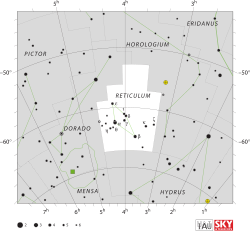
| |
| Observation data Epoch J2000.0 Equinox J2000.0 (ICRS) | |
|---|---|
| Constellation | Reticulum |
| Right ascension | 04 01 18.15162 |
| Declination | −61° 04′ 43.7559″ |
| Apparent magnitude (V) | +4.97 |
| Characteristics | |
| Spectral type | K4 III |
| U−B color index | +1.70 |
| B−V color index | +1.42 |
| Astrometry | |
| Radial velocity (Rv) | +60.5±0.8 km/s |
| Proper motion (μ) | RA: +66.79 mas/yr Dec.: +94.80 mas/yr |
| Parallax (π) | 10.22 ± 0.16 mas |
| Distance | 319 ± 5 ly (98 ± 2 pc) |
| Absolute magnitude (MV) | +0.02 |
| Details | |
| Radius | 24.3+1.9 −4.7 R☉ |
| Luminosity | 179.8±5.1 L☉ |
| Temperature | 4290+261 −158 K |
| Other designations | |
| ι Ret, CPD−61° 293, HD 25728, HIP 18772, HR 1266, SAO 248927 | |
| Database references | |
| SIMBAD | data |
ι Reticuli, Latinized as Iota Reticuli, is a solitary, orange-hued star in the southern constellation of Reticulum. It is faintly visible to the naked eye, having a combined apparent visual magnitude of +4.97. Based upon an annual parallax shift of 10.22 mas as seen from Earth, it is located around 319 light years from the Sun. At present it is receding from the Sun with a radial velocity of +61 km/s, having come closest to the Sun 883,000 years ago at a distance of 212 light years. Iota Reticuli is moving through the Galaxy at a speed of 80.9 km/s relative to the Sun. Its projected Galactic orbit carries it between 12,300 and 25,100 light years from the center of the Galaxy.
This is an evolved K-type giant star with a stellar classification of K4 III. Having exhausted the supply of hydrogen at its core, the star cooled and expanded off the main sequence; at present it has 24 times the girth of the Sun. It is radiating 180 times the luminosity of the Sun from its swollen photosphere at an effective temperature of 4,290 K.
References
- ^ van Leeuwen, F. (2007), "Validation of the new Hipparcos reduction", Astronomy and Astrophysics, 474 (2): 653–664, arXiv:0708.1752, Bibcode:2007A&A...474..653V, doi:10.1051/0004-6361:20078357, S2CID 18759600.
- ^ Johnson, H. L.; et al. (1966), "UBVRIJKL photometry of the bright stars", Communications of the Lunar and Planetary Laboratory, 4 (99): 99, Bibcode:1966CoLPL...4...99J.
- ^ Houk, Nancy; Cowley, A. P. (1978), Michigan catalogue of two-dimensional spectral types for the HD stars, vol. 1, Ann Arbor: Dept. of Astronomy, University of Michigan, Bibcode:1975mcts.book.....H.
- ^ de Bruijne, J. H. J.; Eilers, A.-C. (October 2012), "Radial velocities for the HIPPARCOS-Gaia Hundred-Thousand-Proper-Motion project", Astronomy & Astrophysics, 546: 14, arXiv:1208.3048, Bibcode:2012A&A...546A..61D, doi:10.1051/0004-6361/201219219, S2CID 59451347, A61.
- Anderson, E.; Francis, Ch. (2012), "XHIP: An extended hipparcos compilation", Astronomy Letters, 38 (5): 331, arXiv:1108.4971, Bibcode:2012AstL...38..331A, doi:10.1134/S1063773712050015, S2CID 119257644.
- ^ Brown, A. G. A.; et al. (Gaia collaboration) (August 2018). "Gaia Data Release 2: Summary of the contents and survey properties". Astronomy & Astrophysics. 616. A1. arXiv:1804.09365. Bibcode:2018A&A...616A...1G. doi:10.1051/0004-6361/201833051. Gaia DR2 record for this source at VizieR.
- "iot Ret". SIMBAD. Centre de données astronomiques de Strasbourg. Retrieved 2017-07-14.
{{cite web}}: CS1 maint: postscript (link) - Eggleton, P. P.; Tokovinin, A. A. (September 2008), "A catalogue of multiplicity among bright stellar systems", Monthly Notices of the Royal Astronomical Society, 389 (2): 869–879, arXiv:0806.2878, Bibcode:2008MNRAS.389..869E, doi:10.1111/j.1365-2966.2008.13596.x, S2CID 14878976.
- ^ Anderson, E.; Francis, Ch. (2012). "XHIP: An extended Hipparcos compilation". Astronomy Letters. 38 (5): 331. arXiv:1108.4971. Bibcode:2012AstL...38..331A. doi:10.1134/S1063773712050015. S2CID 119257644.
| Constellation of Reticulum | |||||||||||
|---|---|---|---|---|---|---|---|---|---|---|---|
| Stars |
| ||||||||||
| |||||||||||
| Galaxies |
| ||||||||||
| |||||||||||